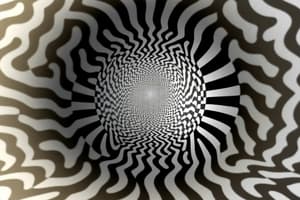Podcast
Questions and Answers
What are visual illusions?
What are visual illusions?
Visual illusions are distortions of perceptions of visual images.
Describe the Müller-Lyer illusion.
Describe the Müller-Lyer illusion.
The Müller-Lyer consists of two lines of equal length each having opposite-shaped patterns on the ends.
Which perspectives explain the Müller-Lyer illusion?
Which perspectives explain the Müller-Lyer illusion?
- Behavioural perspective (correct)
- Socio-cultural perspective (correct)
- Cognitive perspective (correct)
- Biological perspective (correct)
What does the biological perspective focus on regarding visual illusions?
What does the biological perspective focus on regarding visual illusions?
Explain the behavioural perspective on the Müller-Lyer illusion.
Explain the behavioural perspective on the Müller-Lyer illusion.
What does the socio-cultural perspective suggest about the perception of the Müller-Lyer illusion?
What does the socio-cultural perspective suggest about the perception of the Müller-Lyer illusion?
What does the cognitive perspective emphasize about the Müller-Lyer illusion?
What does the cognitive perspective emphasize about the Müller-Lyer illusion?
How does size constancy work in perception?
How does size constancy work in perception?
What is unique about the shape of the Ames Room?
What is unique about the shape of the Ames Room?
Flashcards are hidden until you start studying
Study Notes
Visual Illusions
- Distortions in visual perception, leading to misjudgment of length, curvature, position, speed, or direction of stimuli.
- The brain, not the eye, is tricked, showcasing failures in visual perceptual principles.
The Müller-Lyer Illusion
- Consists of two lines of equal length, each with opposite arrow-shaped patterns on the ends.
- The feather-tailed line appears longer than the arrow-headed line despite being of equal length.
Explanations of the Müller-Lyer Illusion
- First described in 1889, explanations can be viewed from four contemporary perspectives:
- Biological perspective
- Behavioural perspective
- Socio-cultural perspective
- Cognitive perspective
Biological Perspective
- Focuses on the physiological processes of the eyes, nervous system, and brain.
- The 'Eye Movement' theory posited that increased eye movement influences perception of length.
- This theory has been rejected, as the illusion persists without eye movement.
Behavioural Perspective
- Emphasizes learning and past experience's role in perception.
- The 'carpentered world' hypothesis suggests the illusion arises from our experiences with architectural features.
- Our perception of depth regarding corners influences the interpretation of the lines' lengths.
Socio-Cultural Perspective
- Investigates how cultural and social factors affect the perception of the illusion.
- Research shows that children from 'non-carpentered' environments are less likely to perceive the Müller-Lyer illusion.
Cognitive Perspective
- Highlights the processing of visual information affecting perception of the illusion.
- Misapplication of size constancy leads to the perception of different distances, thus altering size perception of the lines.
- Line endings (arrowheads and feather tails) are interpreted as indicating three-dimensionality, affecting perceived sizes.
Cognitive Perspective: Size Constancy
- Size constancy helps perceive objects consistently regardless of distance.
- It can lead to errors when applied to two-dimensional objects, as seen in the case of the Müller-Lyer illusion.
- Familiarity with building corners informs how we interpret depth cues in the illusion.
Ames Room
- A trapezoidal room that distorts perception of size when a person walks along the rear wall.
- The room's shape encourages the brain's shape constancy mechanisms, leading to mistaken perceptions of size changes depending on position.
Studying That Suits You
Use AI to generate personalized quizzes and flashcards to suit your learning preferences.




